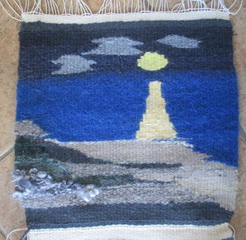Michaela McIntosh Creates Textures from Memories
- evelynrbeck
- Sep 21, 2021
- 2 min read
New Anderson Artists Guild member Michaela McIntosh moved every two years as a child due to her dad’s naval career. “My mom always tried to make a move an adventure,” said McIntosh. “We’d be driving across the country, and she took us to as many sights as possible: the Petrified Forest in Arizona, the Grand Canyon. In Europe, I can’t tell you how many cathedrals we saw.”

After deciding that the nursing degree she was pursuing was not the right fit, she followed her parents to New Zealand, where her dad commanded the Antarctic Support Force. Not only did she meet famed explorer Sir Edmund Hillary, but a seed was planted when she met a woman who spun yarn for sweaters that she sold in a ski shop.
Back home after seven months, McIntosh completed a bachelor’s degree in elementary education (1966 from UNC) and later a master’s degree in special education with an emphasis on learning disability (1983). Her first teaching job was in Atlanta in 1966. But her most memorable year was teaching Spanish, math and high school art in a tiny town of 175 in eastern Oregon. On an art budget of $99, she taught drawing and painting (watercolor and acrylics) and dug a pit for pit-fired pottery. For their final project, students created their own picture in the style of a chosen artist, then wrapped their picture around old wooden stadium chairs. “Those kids didn’t value what they did,” she said. “They wouldn’t believe they had been drawing stick figures at the beginning of the year.”
After retiring, McIntosh relocated to Seneca to be near her daughter, and she dove into a renewed passion for weaving. At one time, she had as many as seven looms but now has three, one of which is loaded with linen for a rug and the other two used for smaller tapestries. A big influence was a class she took with tapestry artist James Koehler. His instruction on a double weave tapestry technique led her to create a piece she’s particularly proud of. “I had a picture in my mind of a spot on the Deschutes River,” she said. “The tops of the salt looked like stepping stones, and the water flowed between them.”
Another piece, which features moonlight on ocean water, used yarn that was homegrown, handspun, and hand dyed, as well as some yarns from Tibet to capture pebbles on the beach.
Her process, which often starts with a memory she captures in a sketch, is slow. She is particularly drawn to colors and to finding the right textures through the different qualities of the yarn.
Despite a recent tornado that damaged her house and took down 13 trees, this world traveler feels at home in the Upstate. “I’m so excited at the reception that art gets here and the openness of the art community,” she said.




























Comments